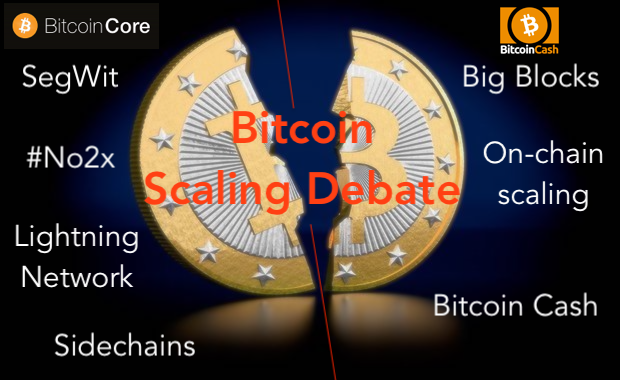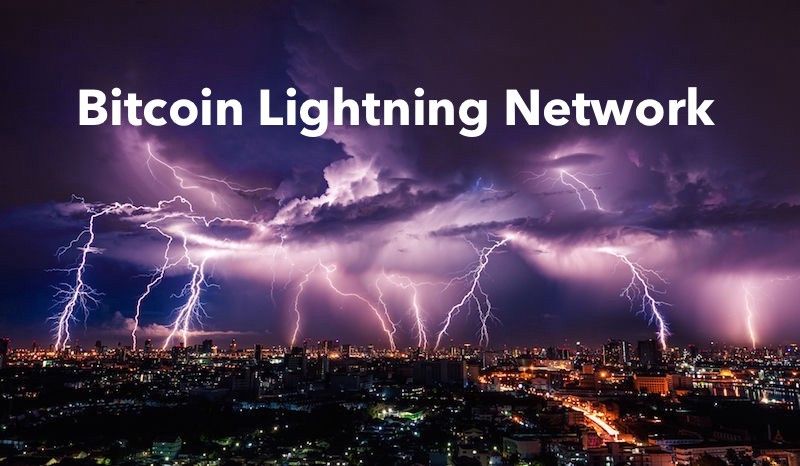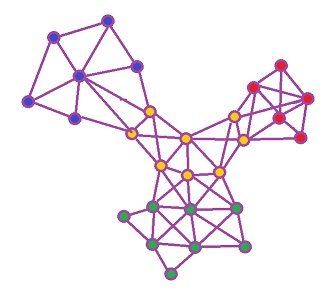Hoping for a Lightning Strike — Bitcoin Scaling Debate Explained
The Bitcoin community has been a united community for almost a decade now, with anti-fiat memes and slogans originating from the dawn days of 2009.
However, recently with Bitcoin being used more and more by users, the community has realized that we need to implement a way to scale Bitcoin so it can operate with more transaction volume.
The problem is that the community has been ripped into two sides by this rift, with one division supporting the Core developers' scaling solution (Segwit and Lightning Network), and the other division supporting bigger block sizes. But what does this mean, and how will it affect Bitcoin in the future?

In the end, two scaling models have developed: the Core model (off-chain scaling) and the Cash model (on-chain scaling). In the below sections, we'll give an unbiased overview of both models and see how they affect Bitcoin.
Core Model: Off-chain Scaling
Bitcoin Core is the first full-node client built for Bitcoin, originally spearheaded by Satoshi Nakamoto himself.
Since then, Satoshi has more-or-less "gone off into hiding" while Bitcoin developers have been joining a Bitcoin innovation company called Blockstream. Core developers and Blockstream both support scaling Bitcoin through the use of off-chain scaling, which employs the following technologies:
- Segregated Witness (SegWit)
- Sidechains
- Lightning Network (LN)
Segregated Witness
SegWit was the first stage of the Core scaling model, implemented a few months ago.
It was implemented in a soft fork, meaning usage of Segwit is completely optional.
The reason for the scaling debate is because of a line of code Satoshi added himself to the consensus rules, setting the maximum block size limit of a single block in the blockchain to 1.00 MB.
However, this limit (pre-SegWit) calculation included all of the signature/witness data for each transaction (the data that validates the transaction, providing a 'digital signature'). Segregated Witness separates this signature data from the transactions themselves, allowing for the 1 MB size limit to be met with even bigger blocks.
Theoretically if an overwhelming majority of users/nodes/miners relied on SegWit, blocks could be as high as 1.7 MB or more, in size. SegWit also allows for new concepts such as the Lightning Network to properly work on the blockchain.
Lightning Network
The Lightning Network is an effort to create a low-fee, instant confirmation mesh network for the Bitcoin cryptocurrency.
Basically, rather than sending every transaction to the blockchain and waiting for confirmation, the LN relies on the creation of payment channels between users. If I plan to pay Starbucks in Bitcoin many times, we can create a payment channel together.
Whenever I want to pay Starbucks, I send an updated transaction script via our payment channel with an updated payment amount. In the end, if Starbucks or I want to cash out our payment channel, we can close the channel and push it to the blockchain.
The only times I interact with the main blockchain are the opening and closing of the payment channel. All other transactions are instant-confirmation, high-speed, zero-fee ones.
Lightning.network is the official website for the effort, which is being spearheaded by a company named Lightning Labs.
Lightning, Strike Us Soon!
The problem is that Lightning is taking quite some time to build.
The current beta allows for lightning interaction on Bitcoin Testnet, but the full release is slated for months away.
Many users are frustrated because Bitcoin transactions without the support of the Lightning Network are:
- taking too long to process/confirm
- swallowing too much in fees
Currently, the hope for the Core model is that when lightning strikes (if it strikes soon), things will be fixed and we'll be back to our 'Bitcoin Utopia' with low-fee instant-confirmation transactions.
Cash Model: On-chain Scaling
Bitcoin Cash is a new cryptocurrency forked from Bitcoin, created in August 2017.
It utilizes a scaling solution supported by most of the 'alternate' node developers, such as Bitcoin Classic and Bitcoin ABC.
Currently, Bitcoin Cash (BCH) took a huge leap in the past few days and is now sitting as the second-ranked cryptocurrency.
Block Size Increase
Rather than dealing with off-chain solutions like SegWit and Lightning Network, Cash supporters believe in on-chain scaling in the form of raw block size increases.
BCH changed the block size of their chain to a whopping 8 MB, eight times larger than the core chain's block size.
Other than new difficulty algorithms, this is the main difference between the Cash chain and the Core chain at the moment, and there exist pros and cons to a block size increase.
Pros and Cons
The obvious advantages of a block size increase are faster confirmations and lower fees. Sending transactions on Bitcoin Cash takes a very low amount of time due to the huge block space, and since so many transactions can fit into a block, the fees are also quite low.
Compared to the core chain, sending a transaction on the Cash chain is much faster and less expensive.
However, there do exist disadvantages with a block-size increase, regarding the viability of nodes. Since the job of a full node involves downloading, validating, and processing full blocks constantly as they arrive, running one on Bitcoin Core requires less space and less processing power compared to Cash.
Running a node on Bitcoin Cash requires you to be able to download at most 8 MB of content about every ten minutes, which can seriously add up.
If the blockchain size is too high and running a node is too hard, many nodes may drop out and the blockchain may not be as decentralized as before.
Beauty of the Blockchain
The beauty of Satoshi Nakamoto's ingenious concept is that if a rift like this occurs, both cryptocurrencies can be tested out and over time we can tell which one works better.
Many users think that they have a better solution, and attempt to fork cryptocurrencies and blockchains to test out their concept in real-time.
Most of the forks die out, due to lack of interest and unpopularity.
The ones who survive, however, become part of an ever-growing experiment with the capacity to change money forever.
I'm personally not sure who will win this race, and with BCH going through sudden increases, it's hard to tell.
It looks like in the near future, we'll see which scaling solution works better, and when the dust settles, we'll realize who Bitcoin really is. Throughout this process, it's important to remember that the "enemy of Bitcoin" is not the other side of the scaling debate, and it's definitely not one person or group of people.
Our true enemies are fiat, government corruption, authoritarianism, and financial censorship, and these are the opponents we should try to vanquish.
Thanks for reading,
— @mooncryption













The important thing is to lower the transaction fees for BTC, slow or fast transaction isn't that important as of now, but if fees aren't lowered I don't see good use case future for Bitcoin.
I agree, fees must be lowered if Bitcoin wants to scale properly. Both of these scaling solutions will release in lower fees if both implemented fully, it's unknown which is better.
@mooncryption,
Thanks for the well-written post.
Salutations. JaiChai here.
RE: Your Post
Off-chain transactions such as the LN and its Ethereum counterpart - Raiden - will definitely speed up the lame transactions per second (tps) rate.
But transaction maleability will still be lurking in the background. Granted, it won't tear down the LN, but it will surely cause much heartache and headaches.
IMHO, increasing the block size not only goes against the decen tenet, it is merely a quick fix, band-aid approach; "kicking the can" down the road for the next wave of developers to deal with; that is, a humongous, super-bloated blockchain!
Ethereum's "sharding" appears to be a technically more effective approach for longterm scalability.
Just musing...
Upvoted and continuing to follow you, my friend.
Namaste,
JaiChai
Thanks for your comment! You're right, Ethereum has very promising scaling solutions like Raiden and Sharding. The Lightning Network + Segwit combo theoretically can boost the raw rate to millions or billions of transactions per second.
The only problem is that currently Lightning Network is not out yet, and SegWit alone isn't able to mitigate these issues which is why the main chain is so bloated.
@mooncryption,
Thanks for replying.
"First to market" - It's not a delicious, little brown Filipina taco, BUT it's still a beautiful thing, no?
Lol!
Namaste,
JaiChai
img credz: pixabay.com
Nice, you got a 56.0% @peaceandlove upgoat, thanks to @mooncryption
It consists of $15.46 vote and $0.37 curation
Want a boost? Minnowbooster's got your back!
The @OriginalWorks bot has determined this post by @mooncryption to be original material and upvoted(1.5%) it!
To call @OriginalWorks, simply reply to any post with @originalworks or !originalworks in your message!
When I spin, @mooncryption, I always spin in your favour! I also remember every single time you fed me. You started feeding me 14 days ago and fed me 2.4 STEEM in total.Thank you for being good to me and helping me become stronger! Our common cause will help many people.
Yours, Spinny
I like very much when everyone who feeds me also reads my friend’s posts, so please visit @tanglebranch and read what he has to say! Your name will also appear here. :-) Join my Discord server if you want to meet others: https://discord.gg/Mz2EZP3
Powered by @adsactly.
It sounds incredible... thanks for the information
Resteemed by @resteembot! Good Luck!
Curious?
The @resteembot's introduction post
The @reblogger's introduction post
Get more from @resteembot with the #resteembotsentme initiative
Check out the great posts I already resteemed.
Bitcoin uses up the energy supply of a medium size country...BCH will require the computing and energy power far beyond that. Miners in the western world where renewable energy isnt common will have to move away from this...it is just too costly.
Here is the mouthfull in your highly educational summary, for which I thank you @mooncryption: "The problem is that Lightning is taking quite some time to build."
The longer it takes for Lightning to arrive for public use, and if the big money that is supporting BCH resolves to stay the course in their struggle, the greater the headwinds for BTC.
For those of us who are stressing the store-of-value use case for BTC, neither the slowness nor the fees are a serious impediment to getting on board, in my opinion. Strengthening this use case is a now awesome depth of international network strength/support, at least compared to all other cryptrocurrencies.
Add to this the growing chorus of informed macro-economics analysts who are now warning us that a currency reset "will be here any day now". I see the trigger for that reset being a big war that somebody has started; because the one thing that this will do is the ramp up the printing of fiat money to lend to governments already totally unable to repay their debts. So my prediction is that once w eget into that war BTC will go to the moon on the store-of-value use case.
I also predict that if the Big-Money institutional traders become convinced of the long term viability of BCH, they are simply going to work with both BCH and BTC. Since only some of the hedge fund guys have really come on board at this point, we could see both of them go to the moon in due course after the really big money gets int the crpto space, I think.
I hasten to tell you that when I was active in the stock market I got sick of my predictions being almost all wrong!
Blockchain is changing the world
Very Good.....